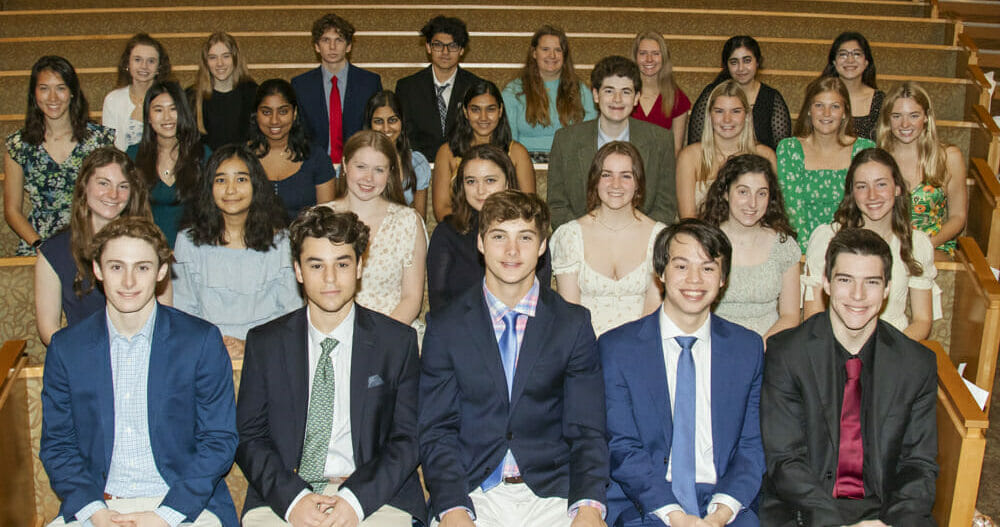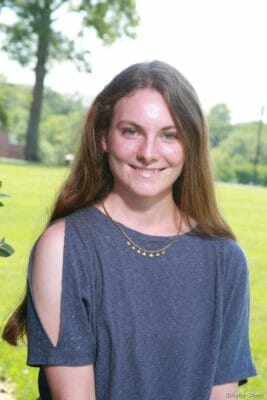Students Share Perspectives on Complex Issues
On April 22, 2022, 29 MICDS seniors were inducted into the Cum Laude Society. As part of the induction process, each candidate shared one of their Common Application essays for review by the Cum Laude faculty members. The faculty selected Sam Baumohl ’22 and Sophie Fendler ’22 to share their essays during the ceremony. We hope you enjoy reading this snapshot of their unique perspectives on life and complex issues.
 Cum Laude Essay by Sam Baumohl ’22
Cum Laude Essay by Sam Baumohl ’22
I used to believe that pie was easy, but after learning about the bureaucratic red tape that surrounds pie, pie is not as easy to slice as one would think.
To determine what makes the pie so easy, I needed to answer a straightforward question: what is a pie? It might seem like a simple question. A pie is just some fruit or jelly baked into a crust. But there are shepherd’s pies, which aren’t sweet but savory. I looked to the internet to solve this pizza paradox providing me with disproportionate amounts of pain. I searched, «legally, what is a pie?» I was met with pages of results filled with definitions of Public Interest Entities, a legal definition for tax purposes in multiple countries. As exciting as tax law can be, this was not what I was looking for. I amended my search terms and continued onward. Interestingly, the U.S. Federal Government has a legal definition of a frozen cherry pie but does not define any other pie. The same law can be found under Title 21 Chapter 1 Subchapter B Part 152 Subpart B Section 152.126, where a frozen cherry pie is defined as «food prepared by incorporating in a filling contained in a pastry shell mature, pitted, stemmed cherries that are fresh, frozen, and/or canned.» According to the FDA’s copy of the law, this definition was last updated in November 2020. This leaves me with some questions: why did the FDA feel the need to update the legal definition of a frozen cherry pie? Why does the U.S. government need to define precisely what a frozen cherry pie is, how to make it, and how to label it failing to meet these requirements? More importantly, I was baffled that there were no definitions for other pies. Under Subpart B, «Requirements for Specific Standardized Fruit Pies,» there is only the specification for the frozen cherry pie. Why!? This implies that the U.S. Government thinks cherry is the only fruit, or that frozen cherry pie is the only pie? I am in too deep, and I need to know why the U.S. government carefully regulated cherry pies and ONLY cherry pies.
To my surPIEse, I found multiple articles talking about this hilariously niche food law. This standard belongs to a set of FDA regulations enacted in the 1970s to force producers to create accurate labels. It has been a source of controversy. Many pie makers point to the exact requirements listed in the standard as an example of arcane government over-regulation and have pushed for its removal. Some have cited the lack of standards for other pies as evidence of the law’s needlessness. In 2019, they almost accomplished their goal. As the Trump administration wanted to take a win for deregulation, the FDA released a statement saying they would be reviewing a proposal to remove the standard and that comments could be taken for 90 days. That comment period ended months ago, and the only update I found was an FDA press release stating that the removal of the standard would have innovation benefits and little downside. The law still appears to be on the books, and so it seems pie makers will still have to ensure at least 25% of a frozen cherry pie in weight is actual cherries.
After doing deep-dives into any topic, I suddenly start to see this new topic everywhere. This phenomenon certainly happened with the strict frozen cherry pie standards. I could only find apple, but not cherry, mini pies at McDonald’s. Would the McDonald’s cherry pies be too small? Notably, the standard requires cherry pies to be at least four inches in diameter. Or could it be that such a small pie would struggle to meet the 25% weight in cherries requirement Regardless, the precise regulation of frozen cherry pie adds an extra layer of difficulty that challenges the assumptions we make when we say something is «as easy as pie?» Essentially, pie is not as easy as one would think. Until frozen cherry pies are free from the grips of tyrants like the Food and Drug Administration, it will remain that way.
 Cum Laude Essay by Sophie Fendler ’22
Cum Laude Essay by Sophie Fendler ’22
“Paper or plastic?” The grocery store cashier asked me. Considering the average American shops at a grocery store once a week, they hear that phrase over 4,000 times in their life. It seems only natural that a few would stop to think about the consequences of that single question. That day, I did. The word plastic bag brought about images of the “plastic crisis»: beaches covered in dirty plastic bags; various dying or dead sea animals with plastic bags wrapped around their bodies. The same plastic bag that carries home my groceries could end up in a sea turtle’s stomach. Paper bags brought about images with a less worldly impact: myself, with a torn paper bag and my groceries rolling under cars.
This scenario, choosing between paper or plastic, is an example of the short- and long-term consequences that can stem from a single decision. The scientific name for this scenario is the butterfly effect, a thought experiment where a butterfly flaps its wings in New York, resulting in a tornado halfway around the world. The idea is that a small action can have an enormous impact.
I first learned about the butterfly effect from my knowledgeable friend in elementary school. The incredible nature of the idea sparked my curiosity of the world around me. I remember beginning to appreciate the perfect timing of events. Stopping to tie my shoe on the playground meant I missed out on french fries at lunch. Doing something nice for a friend in math class resulted in a good citizen reward. Some call it karma, some call it fate, some call it what goes-around-comes-around. But I knew that cause and effect were at work. Zeno of Citium, a pre-Socratic Greek philosopher, noted that fate is the «endless chain of causation.» It is why I loved our sixth-grade Rube Goldberg physics project. Chain reaction machines are cause and effect in real-time. Even after the project ended, I obsessively watched videos of and created chain reaction machines with my younger brother. One day, my mother came home to the entire kitchen covered in dominos, ping pong balls, legos, and train tracks. After my brother and I made her watch countless “slow-mo” videos of our contraption, I told her I wanted to be a physicist.
Years later, in 8th grade, I received a book from that same knowledgeable friend called What If?: Serious Scientific Answers to Absurd Hypothetical Questions. In a matter of days, I read the book cover to cover multiple times. I explained various passages to whoever would listen: my family, friends, and science teacher. The author of the book used science to explore the effects of questions like «What if you put all the periodic elements in the same room» (a really big explosion), or «What if you tried to hit a baseball at 90% the speed of light» (another really big explosion). Real science, I realized, was all about cause and effect.
As I grew older, I learned the world was controlled by more complex systems. I began to understand that the nature of particles, the Uncertainty Principle, and thought experiments like Schrodinger’s Cat, were all scientific laws and theories that made the butterfly effect so much more complicated, and so much more intriguing.
When I mention my passion for physics, I have noticed people think it is all about complicated math. It is also the scientific field of cause and effect. Physicists ask what came before and what comes after. They are fortune tellers and time travelers. The more I learn, the more I feel that I have my own secret lens with which I view the world. With it, I can see what others cannot.
So, in answer to my question, «I’ll take paper please.» Let’s hope this scenario does not end in an explosion, but who knows, the world is complex.
Congratulations to Sam, Sophie, and their classmates on being inducted into the 2022 Cum Laude Society!

 Cum Laude Essay by Sam Baumohl ’22
Cum Laude Essay by Sam Baumohl ’22 Cum Laude Essay by Sophie Fendler ’22
Cum Laude Essay by Sophie Fendler ’22